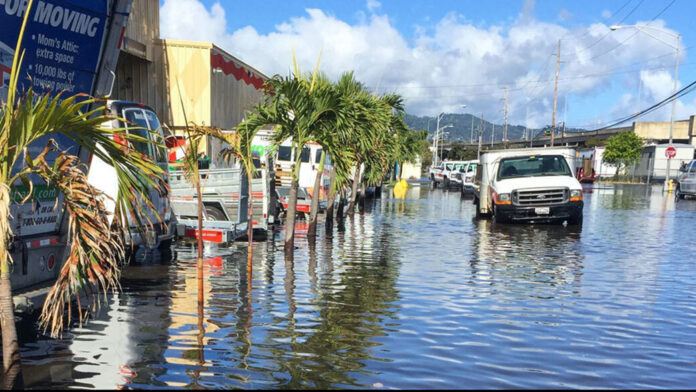Sunny-day flooding is already a problem in low-lying coastal areas around the world. The occurrence is most often associated with peak tides. But it also is happening during storm surges. Global warming is playing its part producing two consequences:
- ocean thermal expansion – as atmospheric heating penetrates surface waters, ocean circulation is spreading the heat throughout the water column causing the overall volume to increase.
- melting of continental glaciers, ice shelves, and sea ice – the warming ocean and land is accelerating melting across the globe but more noticeably at the poles adding trillions of tons of meltwater causing sea levels to rise.
We know the Moon as it circles our planet is a major influencer of ocean tides. But sometimes when the Moon and the Sun align, we get higher than normal tides. When they are on opposite sides of the planet then tides are lower. And as much as we think of the Moon orbiting Earth as a constant, it’s not. Its orbital plane does not match up with the Earth’s axial rotation. Hence it appears some nights to be higher in the sky, and on other nights much lower. That is the wobble NASA scientists are talking about, an 18.6-year cycle. The implications for our planet, say the scientists, are simple. Low-lying areas need to look out for a dramatic increase in coastal flooding by the mid-2030s.
In June 2021, a published study appeared in Nature Climate Change entitled “Rapid increases and extreme months in projections of United States high-tide flooding.” Scientists from Hawai’i, NOAA, Jet Propulsion Laboratory Pasadena, and the Scripps Institution of Oceanography, UC San Diego, were the authors. In it, they write that by the mid-2030s there will be a rapid increase in high tide flooding on coastlines around the world. The article’s focus, however, is largely the continental U.S.
In a press release issued by NASA, Bill Nelson, Administrator stated, “The combination of the Moon’s gravitational pull, rising sea levels, and climate change will continue to exacerbate coastal flooding on our coastlines and across the world. NASA’s Sea Level Change Team is providing crucial information so that we can plan, protect, and prevent damage to the environment and people’s livelihoods affected by flooding.”
Principal author of the study, Phil Thompson from the University of Hawai’i notes in the release that “the accumulated effect over time…will have an impact.” What impact exactly?
The Moon wobble cycle of 18.6 years either suppresses daily ocean tides or amplifies them. First observed and recorded in 1728, what’s making the 2030s more significant is the accumulated and accelerating rise in sea levels caused by a warming atmosphere and ocean. Currently, we are in the tide-amplifying latter half of a wobble cycle where sea levels right now haven’t yet reached a point to noticeably change flooding thresholds. Even now, however, we see increased sunny day flooding in places like Florida, the Chesapeake Bay area, and the Carolina coast. But in the 2030s with another decade of accelerating sea-level rise under our planet’s belt, that frequency will increase to what may become a chronic climate condition.
What exactly is the historic and current rate of sea-level rise? Observations by tidal gauge from the 19th through the 20th century, and in the latter few decades from satellites, indicate a global mean rise of 16 centimetres (approximately 6 inches). But what is of greater concern is the accelerating rate of the rise in the last decade, calculated at 3.6 centimetres (1.45 inches). That means 24% of the total rise over a century and a half has happened in the last ten years. And the acceleration is continuing.
How will this play out? For mid to low-latitude coastal communities, it will mean a leap in the number of flood days each month. Thompson talks about “floods 10 or 15 times a month.” At that rate, how sustainable will existing coastal communities be? Unless they are developing mitigation and adaptation strategies, we will see more of what you see in the image that appears with this posting.
NASA is as vulnerable to sea-level rise as the rest of the U.S. coast. Cape Canaveral where the agency launches most of its rockets is barely above sea level. The same is true about Wallops Island where other launches occur.
So NASA has created a series of high-tide flood tools and made them accessible through a sea-level portal on the web. The portal provides flood day projections, data analysis, sea-level evaluation and assessment, and a virtual Earth system laboratory.
The NASA release noted that the coastlines of the entire lower-48 states and Hawai’i will be most impacted by sea-level rise in the 2030s. Only Alaska will be spared. Why is that? Because Alaska is still rising from being weighed down by the thousands of metres of glacial ice that covered it until 11,700 years ago. Alaska along with northern Canada, Scandinavia, and northern Russia have been experiencing an isostatic rebound, a slow release and rise of land formerly buried by ice. The land rise will more than offset the sea rise.
For the U.S., however, from the Texas Gulf coast to the Chesapeake Bay, expect chronic coastal flooding. New York City and Boston will not be spared. Nor will the Atlantic provinces of Canada, lowlands in Northern Europe, Asia, Africa, South America, and Australia. Even inland bodies of water like the Great Lakes of both Africa and North America will see shoreline inundations as the combination of increasing volumes of larger warmer bodies of water get pulled by amplified lunar gravitational forces.
Ben Hamlington at the Jet Propulsion Laboratory in Pasadena, California, one of the authors of the paper talks about the importance of the NASA sea level portal stating, “From a planning perspective…understanding that all your events are clustered in a particular month, or you might have more severe flooding in the second half of a year than the first – that’s useful information.”








